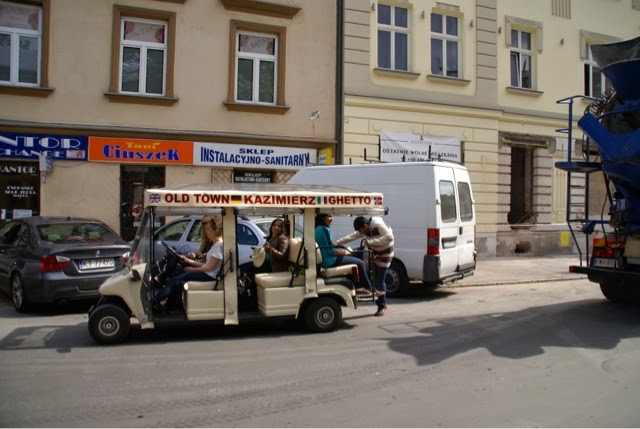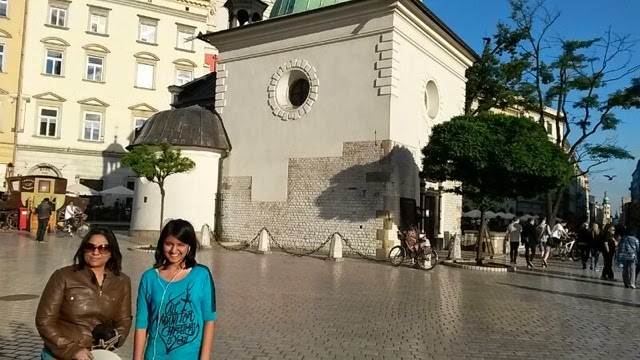Once outside the Wawel castle, it was 2:45pm, we wanted to go the Oskar Schindler factory. We were wondering how to reach it. We were approached by two girls in an electric car ( golf buggy) who offered to drop us to there and included a tour of the Jewish area for 160zl (1 polish zloty= Rs.20). We bargained with them and they agreed for 100zl.
They had a recorded audio on their iPhone giving a description of the places we reached, which one of them would connect to the speakers. As we wanted to reach the Schindler factory by 4pm, we thought it would be a good opportunity to see the Jewish area also.
Poland is a place where Polish Jews and Polish Catholics lived together side by side for generations. The Jews had been present in Poland and Kraków since the very beginning. Their population grew rapidly over time, thanks to the religious tolerance and social autonomy they were granted here. The Jews, who had been expelled from countries all around Europe, found their home in Poland.
We went to a couple of churches along the route.
Then to a few synagogues.
Kazimierz – the district south of the Old Town between the Wisła River(Vistula river)
and ul. Dietla (where a tributary of the Wisła once flowed) was the centre of Jewish life in Kraków for over 500 years, before it was systematically destroyed during World War II. Rediscovered in the 1990s, thanks to the fall of the regime and worldwide exposure through the lens of Steven Spielberg, traces of Kazimierz’s Jewish history have not only survived, but literally abound in the form of the district’s numerous synagogues and Jewish cemeteries. In fact, no other place in Europe conveys a sense of pre-war Jewish culture on the continent better than Kazimierz. Peeling façades and obscure courtyards hide dozens of bars and cafes, many affecting an air of pre-war timelessness.
and ul. Dietla (where a tributary of the Wisła once flowed) was the centre of Jewish life in Kraków for over 500 years, before it was systematically destroyed during World War II. Rediscovered in the 1990s, thanks to the fall of the regime and worldwide exposure through the lens of Steven Spielberg, traces of Kazimierz’s Jewish history have not only survived, but literally abound in the form of the district’s numerous synagogues and Jewish cemeteries. In fact, no other place in Europe conveys a sense of pre-war Jewish culture on the continent better than Kazimierz. Peeling façades and obscure courtyards hide dozens of bars and cafes, many affecting an air of pre-war timelessness.
I was excited as this was the first synagogue we were going to see. The synagogue is not only a religious place but also a meeting point for the jewish community. The genders pray separately inside. The Temple Synagogue had very grand interiors.
Temple Synagogue
The Old Synagogue
In 1796 Kraków came under Austrian control, and four years later Kazimierz was incorporated into its neighbouring city. This brought about the area's rebirth as the Austrians worked hard to redevelop the city: the streets were cobbled, the crumbling defensive walls were torn down, the first gas lamps were illuminated in 1857, and the suburb had a power station by 1905. The governing Austrians also ordered all of Kraków’s Jews to resettle in Kazimierz, and a rich cultural life arose around them; by 1910 the Jewish population stood at 32,000, a figure that was to nearly double during the inter-war years. This came to a dramatic end with the Nazi occupation of Kraków and Hitler’s systematic extermination of the Jews of Europe. Herded across the river to a ghetto in Podgórze, Kraków’s Jews met their end there, in Płaszów, or Bełżec (primarily). A mere 3-5,000 survived the Holocaust, a large proportion of them saved by Oskar Schindler.
Although 5,000 Jews were registered as living in Kraków in 1950 any hopes of rekindling the past soon vanished. The anti-Zionist policies of the post-war communist authorities sparked waves of emigration to Israel, and by the 1970s signs of Jewish life had all but disappeared and the area had become a bandit suburb. The fall of communism in 1989 sparked new hope, however; investment began trickling in, 1988 saw the first Jewish Festival take place, and five years later the Judaica Foundation was opened. That was also the year Spielberg arrived to film Schindler’s List, a film that would put Kazimierz on the world map and irrevocably change its fortunes. Today a visit to Kazimierz ranks just as high on itineraries as a trip to Wawel, illustrating the historical importance and public regard the area possesses.
Then they dropped us to the Oskar Schindler factory around 4pm.
The exhibition at the factory was very good and was also about Poland during the world war II and not just about the Jews or just about Oskar Schindler(28 April 1908 – 9 October 1974) was an ethnic German industrialist, German spy, and member of the Nazi partywho is credited with saving the lives of 1,200 Jews during the Holocaust by employing them in his enamelware and ammunitionsfactories, which were located in what is now Poland and the Czech Republic respectively. He is the subject of the 1982 novelSchindler's Ark, and the subsequent 1993 film Schindler's List, which reflected his life as an opportunist initially motivated by profit who came to show extraordinary initiative, tenacity, and dedication in order to save the lives of his Jewish employees.

Just before leaving for Europe, Shaleen and I watched the movie Schindler's List again. After watching it, I was seriously wondering if I had done the correct thing to plan a trip to Krakow. We were stunned to think that we would soon be standing on the same soil where all this had taken place. Poland has spent centuries at the pointy end of history, grappling with war and invasion, and, the point has most often, than not, been Krakow. The exhibition at The Oskar Schindler factory was par excellence. It required more than the the two hours we devoted it.
At the Harris Piano Jazz bar
Europe's largest medieval town square"Rynek Glowny" once more
Entrance to our apart hotel. We took a taxi to the station. The fare was around 20zl.





























































